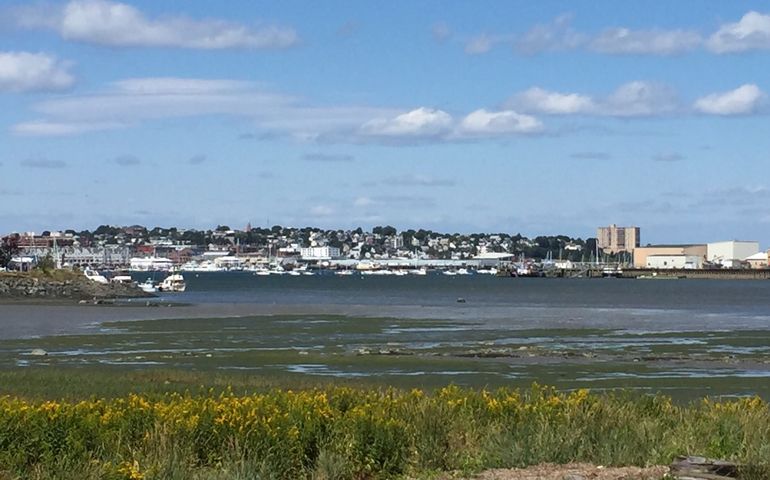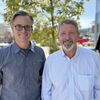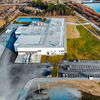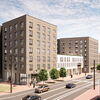Processing Your Payment
Please do not leave this page until complete. This can take a few moments.
- News
-
Editions
View Digital Editions
Biweekly Issues
- December 15, 2025
- December 1, 2025
- Nov. 17, 2025
- November 03, 2025
- October 20, 2025
- October 6, 2025
- + More
Special Editions
- Lists
- Viewpoints
-
Our Events
Event Info
Award Honorees
- Calendar
- Biz Marketplace
6 ways new climate plan could change Portland-area development
 Photo / Maureen Milliken
Portland as seen across the Fore River from South Portland. The two cities are collaborating on the One Climate Future plan, and have issued a report calling for major changes in the way development and resources are looked at.
Photo / Maureen Milliken
Portland as seen across the Fore River from South Portland. The two cities are collaborating on the One Climate Future plan, and have issued a report calling for major changes in the way development and resources are looked at.
A climate resilience plan for Portland and South Portland that's been in the works for three years would mean sweeping changes to how developers and businesses operate in both cities, as well as affect almost every layer of city government.
Some of the goals in the draft of the One Climate Future report, released last week, are:
- Both cities operating entirely on renewable energy by 2040;
- Reducing greenhouse gas emissions by 80% by 2050;
- New buildings to be net energy zero by 2032;
- Housing stock meeting workforce demand by 2035;
- Reducing organic waste in the waste stream by 70% by 2030;
- Converting 15% of the cities' impervious surfaces to green space by 2050.
The changes in the 300-page report come down to "six big moves" and more than 70 related suggestions covering not only how buildings are constructed and what energy is used for power, but also how public transportation will work and how entire neighborhoods are developed.
The South Portland City Council plans to discuss the report in a workshop Tuesday, Sept. 29; the Portland City Council will take it up at a date that hasn't been set. Portland's Sustainability and Transportation Committee endorsed the plan Aug. 26. Both councils would have to formally adopt the plan before city governments could start working on the changes suggest.
The two cities, surrounded by water and already affected by rising seas with more frequent flooding, began collaborating on a climate plan in 2017. The One Climate Future effort was launched in June, though work on the report itself began 18 months ago. The process included thousands of resident surveys, workshops, and input from city staff, businesses and local leaders, a news release accompanying the report said.
The six general moves the report suggests are:
Build better buildings. A key milestone is that all new buildings would be net-zero energy starting in 2032. Overall, the goal is for new policies that would improve how buildings are designed, built and retrofitted.
"Creating spaces to live and work that are more energy efficient, comfortable, healthier, resilient to extreme weather, and powered by renewable energy." The goal is to build smarter, not more expensively, the report says. "And to ensure everyone can benefit from climate-ready homes. We will work to expand financial incentives to make retrofits more affordable, encourage upgrades to rental properties to lower renters’ utility bills, and continue to expand our cities’ low-carbon and resilient affordable housing."
Connect people to places, to opportunity. Key milestones are that by 2035, 26% of trips in both cities will use public transit or active transportation (up from 12%) and housing stock will meet workforce demand by 2035.
The plan suggests creating "connected neighborhoods" where people can get to parks, stores and services more easily by walking, in a wheelchair, riding a bike or taking public transportation. The goal requires safer street design, building out a network of bikeways and "radically expand our public transit system, while making travel on transit more accessible and seamless."
It would be supported by land use policy that would cluster mixes of housing and businesses near transit, and increase housing in the cities to bring people closer to jobs. "And we will ensure that the people who most rely on public transit systems, due to income, disability, or otherwise, are part of the decision-making teams connecting our homes, businesses, open spaces, and community resources," the report says.
Power everything with clean renewable electricity. Key milestones are replacing 80% of natural gas and heating oil use in residences with electric heating and cooling systems by 2050; installing 50 megawatts of solar in the two cities by 2030 and 245 megawatts by 2050; and all-electric Greater Portland METRO and South Portland Bus Service fleets by 2040.
The effort would be supported by rebates, tax incentives and federal funding. "The proportion of electricity that comes from renewable sources in Maine will ramp up to 100% by 2050, driven by the new renewable portfolio standard," the report says. "The RPS is vital to transforming Maine’s energy sector and to reaching our cities’ carbon reduction goals. We will continue to advocate for the timely implementation of the state RPS and lead by example: we will meet all municipal electricity demand with renewable energy by 2032, and we will launch a solar proliferation strategy with a focus on community solar to expand access to the benefits of clean energy."
Grow a circular economy. Key milestones are reducing organics in the waste stream by 70% by 2030 and achieving “zero waste” (90% waste diverted from waste stream) by 2050.
"The old unsustainable model for economic growth was 'take resources, make products, and discard waste,'" the report says. "We will innovate: we will extend the useful lifespan of materials and products, encouraging alternatives to single-use plastics and growing the sharing economy. We will find new value in waste, using organic waste to improve soil health, expanding the reuse marketplace for building materials, and taking advantage of 'by-product synergies' where one industrial waste stream serves as the source material to another. "
It says that investment in "the people and skill sets to lead growth in clean energy and other regenerative industries," are key. "Through a circular economy, we will build and replenish not only our economic capital, but our natural and community capital, too."
Nourish ecosystems, which nourish us. Key milestones are converting 15% of the cities’ impervious surfaces to green infrastructure by 2050 and ensure that all residents live within a half-mile of a park or open space by then.
The report stresses that natural resources are Maine's biggest assets in facing climate change. "We will continue to protect open spaces and coastal waters to ensure our ecosystems can adapt and thrive despite new pests, invasive species, and climate conditions," it says. That includes also increasing the capacity of our soils, forests and wetlands to sequester and store carbon, and expanding tidal wetlands and living shorelines to buffer neighborhoods against storm surge. It also means capturing and storing more stormwater in green infrastructure systems, which will reduce the effects of coastal acidification and will help continue to support marine industries.
A "more robust tree canopy" is needed to mitigate extreme heat, and protected open spaces will foster community, the report says. Healthy soil and marine ecosystems will cultivate more resilient food systems.
Build collaborative capacity to create this future. Key milestones are creating partnerships and design processes that cultivate collaboration and foster community ownership "starting today," and awarding resilience grants to expand the capacity of local organizations, neighborhood associations and community groups by 2025.
The report calls for creating new systems for working together, locally, regionally and statewide. That means sharing data, as well as improving access to it and generating new data, to make decisions about flood risk, track progress on energy efficiency and improve approaches to transportation demand management, among other things.
"By sharing processes, we will create more integrated transit systems, take advantage of economies of scale in electricity procurement, and magnify the impact of our efforts," the report says. "And we will share resources, equipping the people in our communities who are rich with experiential knowledge and low on resources to lead these solutions."
Mainebiz web partners
I would like to see the City Council, Mayor, and Manager answer questions on how they plan to afford to implement their plan without increasing the burden on the local taxpayers. If you think it is expensive to live or run a business in the city now just wait until this plan takes effect. This will only increase the divide between the haves and the have nots and force the working middle class out of the city and into the neighboring towns that are less expensive and less burdensome. It's funny how the article doesn't talk about that or ask the really tough questions.

The Giving Guide
The Giving Guide helps nonprofits have the opportunity to showcase and differentiate their organizations so that businesses better understand how they can contribute to a nonprofit’s mission and work.
Learn More
Work for ME
Work for ME is a workforce development tool to help Maine’s employers target Maine’s emerging workforce. Work for ME highlights each industry, its impact on Maine’s economy, the jobs available to entry-level workers, the training and education needed to get a career started.
Learn More
Groundbreaking Maine
Whether you’re a developer, financer, architect, or industry enthusiast, Groundbreaking Maine is crafted to be your go-to source for valuable insights in Maine’s real estate and construction community.
Learn more-
The Giving Guide
The Giving Guide helps nonprofits have the opportunity to showcase and differentiate their organizations so that businesses better understand how they can contribute to a nonprofit’s mission and work.
-
Work for ME
Work for ME is a workforce development tool to help Maine’s employers target Maine’s emerging workforce. Work for ME highlights each industry, its impact on Maine’s economy, the jobs available to entry-level workers, the training and education needed to get a career started.
-
Groundbreaking Maine
Whether you’re a developer, financer, architect, or industry enthusiast, Groundbreaking Maine is crafted to be your go-to source for valuable insights in Maine’s real estate and construction community.
ABOUT
NEW ENGLAND BUSINESS MEDIA SITES
No articles left
Get access now
In order to use this feature, we need some information from you. You can also login or register for a free account.
By clicking submit you are agreeing to our cookie usage and Privacy Policy
Already have an account? Login
Already have an account? Login
Want to create an account? Register
Get access now
In order to use this feature, we need some information from you. You can also login or register for a free account.
By clicking submit you are agreeing to our cookie usage and Privacy Policy
Already have an account? Login
Already have an account? Login
Want to create an account? Register







1 Comments